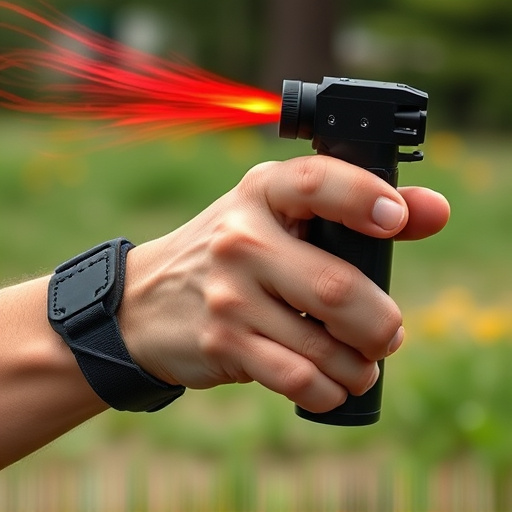Pepper spray, a self-defense tool using capsaicin from chili peppers, requires understanding its effects and proper deployment techniques. Mastering wind direction is key; aiming into the wind ensures maximum coverage on attackers' faces, eyes, or breathing areas. Users should practice in various weather conditions to accurately assess wind speed and direction. Legal restrictions vary by region, so familiarizing oneself with local laws regarding pepper spray carry, storage, and use is crucial for safety.
“Uncover the power of self-defense with an innovative tool—the inflammatory spray device. This comprehensive guide explores the essential aspects of personal safety. We delve into ‘Pepper Spray Wind Direction Tips’, providing insights on aiming for maximum effectiveness. From understanding its basic composition to mastering safety practices and legal considerations, this article equips readers with knowledge to make informed choices. Whether you’re a novice or an expert, these strategies ensure responsible and effective use of pepper spray, empowering individuals to protect themselves in various scenarios.”
- Understanding Pepper Spray: The Basics and Its Composition
- Mastering Wind Direction: Aiming for Maximum Effectiveness
- Safety Tips and Best Practices for Carrying and Using a Self-Defense Inflammatory Spray Device
- Legal Considerations: What You Need to Know About Regulations and Permits
Understanding Pepper Spray: The Basics and Its Composition
Pepper spray, a powerful self-defense tool, is designed to incapacitate an attacker temporarily by causing irritation and pain in the eyes, nose, and throat. Its active ingredient is capsaicin, a chemical derived from chili peppers, which is known for its potent effects. When used correctly, pepper spray can provide valuable time to escape or deter an assault. Understanding how it works and the factors that influence its effectiveness, such as wind direction tips, is crucial for anyone considering carrying this device for personal safety.
The composition of pepper spray includes various additives to enhance its performance. These additives ensure that the capsaicin is delivered effectively, breaking down respiratory barriers and causing the attacker to temporarily lose balance and visibility. Wind direction plays a vital role in using pepper spray successfully; aiming towards the face, eyes, or breathing areas of an assailant can maximize its impact. Knowing how to properly deploy this device and considering environmental conditions like wind speed and direction can make all the difference in self-defense scenarios.
Mastering Wind Direction: Aiming for Maximum Effectiveness
Mastering wind direction is a crucial aspect of using a self-defense inflammatory spray device, like pepper spray, effectively. When deploying such a tool, understanding the wind’s behavior can significantly impact its range and accuracy. Aim for an upwind position; this means you should face into the wind while your target is downwind from you. By doing so, you ensure that the spray moves towards your opponent, maximizing coverage and reducing the risk of missed applications or inhaling the spray yourself.
The key to successful deployment lies in assessing the wind speed and direction accurately. Gentle breezes can be advantageous, allowing for a broader area of impact. Conversely, strong winds might require adjustments to aim higher or lower to compensate for the spray’s potential drift. Practice in various weather conditions will help you develop these skills, ensuring that when faced with an actual threat, you can deploy your self-defense tool confidently and effectively.
Safety Tips and Best Practices for Carrying and Using a Self-Defense Inflammatory Spray Device
When carrying a self-defense inflammatory spray device, such as pepper spray, it’s crucial to prioritize safety and practice best practices. Always ensure the wind direction is in your favor; aiming into the wind can cause the spray to return towards you or bystanders, negating its effectiveness and potentially causing harm. Keep the canister in an easily accessible yet secure location, like a belt pouch or bag, for quick deployment when needed.
Before using the device, familiarize yourself with local laws and regulations regarding its carry and use. Understand the range and duration of the spray’s effect; this knowledge can help you make informed decisions during an encounter. Practice proper hand placement and aim by conducting simulated scenarios with a trained professional to ensure accurate deployment in high-stress situations. Remember, self-defense is about using force only as a last resort, so maintain de-escalation techniques and consider all other options before deploying the spray.
Legal Considerations: What You Need to Know About Regulations and Permits
When considering a self-defense inflammatory spray device, such as pepper spray, understanding legal considerations is paramount. Regulations and permits vary significantly from one jurisdiction to another. In many regions, carrying pepper spray for personal protection is legal but subject to strict rules. For instance, some areas mandate specific types of sprays with limited capsaicin concentrations, while others require registration or licensing.
It’s crucial to familiarize yourself with local laws and regulations regarding the use and possession of inflammatory spray devices. Additionally, understanding pepper spray wind direction tips can enhance safety. When deploying the spray, consider the wind direction to prevent its return towards you or bystanders. Always store your device responsibly and ensure it remains out of reach of unauthorized individuals.
Pepper spray, an effective self-defense tool, relies heavily on proper wind direction for optimal performance. By understanding these simple tips and best practices, users can maximize their safety and ensure the spray reaches its target. Remember, knowledge is key when it comes to self-defense; stay informed about local regulations and permits regarding pepper spray ownership, and always prioritize your well-being in any situation.
